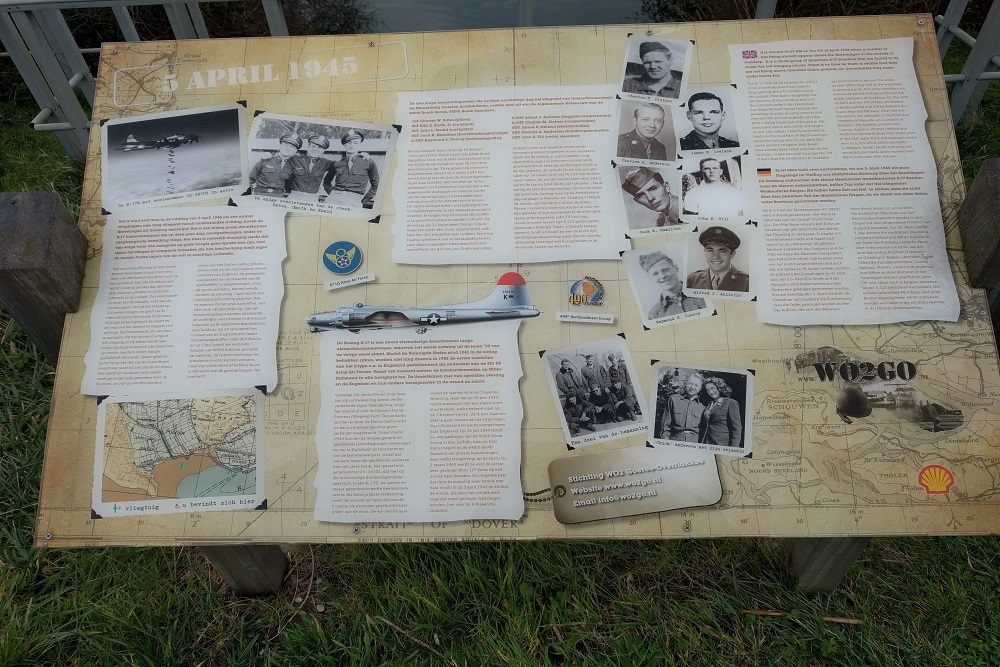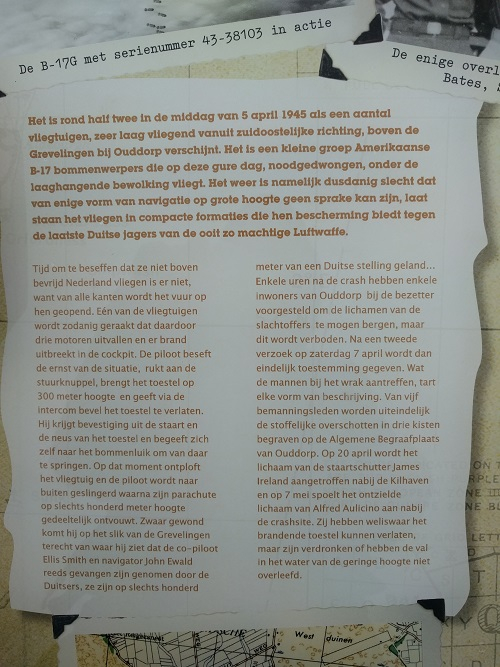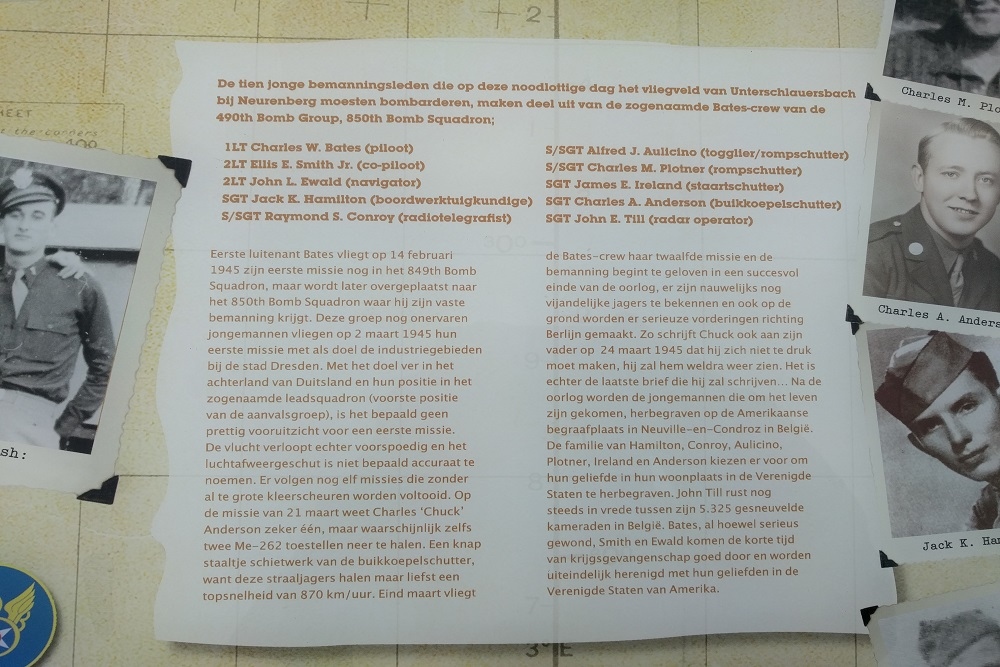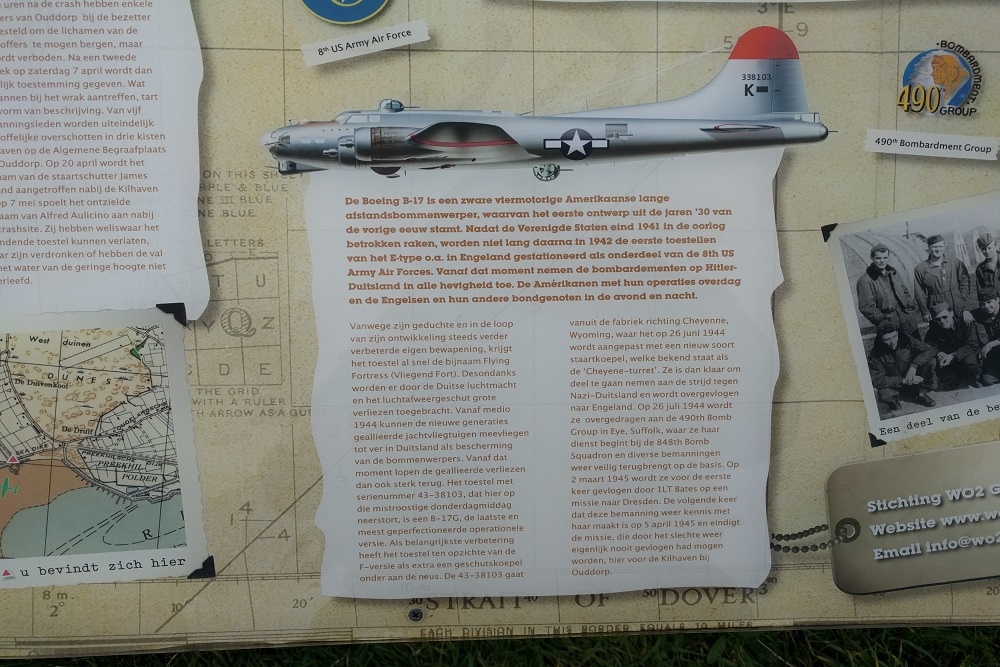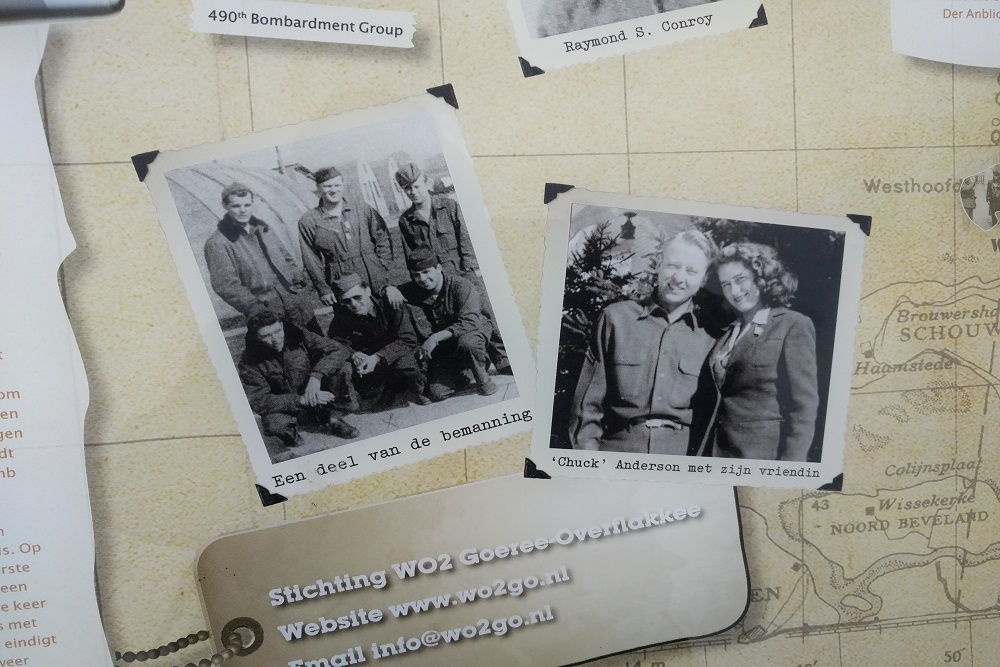B-17G 43-38103 Crash Site Info Panel
Details:
On the south side of the road, in front of the guardrail, near the water.
A rectangular metal panel angled vertically and is supported by two wooden beams, which contains the detailed story of the plane crash of the B-17G #43-38103 aka "Bates Crew". The information panel is printed in color and also features individual and group photos of the crew. The inscription is written in Dutch only and is printed inside the scrap paper images. This panel is dedicated to the crew of Pilot Bates of the 490th Bomb Group, 848th Bomb Squadron. They crashed on 5 April 1945 due to the German AA fire returning from their mission over Germany. Three of the crew survived.
Source of information and photos: www.tracesofwar.com
Monument Text:
(Note: The transcription on the far right of the info panel is not included as we currently have no close-up shot of it. If you have, please feel free to contact us for inclusion.)
Het is rond half twee in de middag van 5 april 1945 als een aantal vliegtuigen, zeer laag vliegend vanuit zuidoostelijke richting, boven de Grevelingen bij Ouddorp verschijnt. Het is een kleine groep Amerikaanse B-17 bommenwerpers die op deze gure dag, noodgedwongen, onder de laaghangende bewolking vliegt. Het weer is namelijk dusdanig slecht dat van enige vorm van navigatie op grote hoogte geen sprake kan zijn, laat staan het vliegen in compacte formaties die hen bescherming biedt tegen de laatste Duitse jagers van de ooit zo machtige Luftwaffe.
|
Tijd om te beseffen dat ze niet boven bevrijd Nederland vliegen is er niet, want van alle kanten wordt het vuur op hen geopend. Eén van de vliegtuigen wordt zodanig geraakt dat daardoor drie motoren uitvallen en er brand uitbreekt in de cockpit. De piloot beseft de ernst van de situatie, rukt aan de stuurknuppel, brengt het toestel op 300 meter hoogte en geeft via de intercom bevel het toestel te verlaten. Hij krijgt bevestiging uit de staart en de neus van het toestel en begeeft zich zelf naar het bommenluik om van daar te springen. Op dat moment ontploft het vliegtuig en de piloot wordt naar buiten geslingerd waarna zijn parachute op slechts honderd meter hoogte gedeeltelijk ontvouwt. Zwaar gewond komt hij op het slik van de Grevelingen terecht van waar hij ziet dat de co-piloot Ellis Smith en navigator John Ewald reeds gevangen zijn genomen door de Duitsers, ze zijn op slechts honderd |
meter van een Duitse stelling geland... Enkele uren na de crash hebben enkele inwoners van Ouddorp bij de bezetter voorgesteld om de lichamen van de slachtoffers te mogen bergen, maar dit wordt verboden. Na een tweede verzoek op zaterdag 7 april wordt dan eindelijk toestemming gegeven. Wat de mannen bij het wrak aantreffen, tart elke vorm van beschrijving. Van vijf bemanningsleden worden uiteindelijk de stoffelijke overschotten in drie kisten begraven op de Algemene Begraafplaats van Ouddorp. Op 20 april wordt het lichaam van de staartschutter James Ireland aangetroffen nabij de Kilhaven en op 7 mei spoelt het ontzielde lichaam van Alfred Aulicino aan nabij de crashsite. Zij hebben weliswaar het brandende toestel kunnen verlaten, maar zijn verdronken of hebben de val in het water van de geringe hoogte niet overleefd.
|
English translation:
It is around 01:30 PM on the 5th of April 1945 when a number of low flying aircraft appear above the Grevelingen in the vicinity of Ouddorp. It is a small group of American B-17 bombers that are forced to fly under the low hanging clouds. There is no time for them to realize that they are not flying above liberated Dutch grounds, for immediately they come under heavy fire.
The B-17 with serial number 43-38103 is hit so severely that three engines stop running and a fire breaks out in the cockpit. Pilot Bates recognizes the seriousness of the situation and over the intercom orders the crew to bail out. Bates himself moves towards the bomb bay in order to jump when at that moment the aircraft explodes and the pilot is being blown out of the plane. His parachute opens only partly at a height of just 100 meters. Heavily wounded he lands on the mud flats of the Grevelingen where he notices that his co-pilot Ellis Smith and his navigator John Ewald have already been taken prisoner by the Germans. It was not until Saturday the 7th of April that the inhabitants of Ouddorp get permission to recover the other airmen. What they find at the wreckage is beyond words. Five crew members are eventually buried in three coffins at the public cemetery of Ouddorp. On the 20th of April and the 7th of May, the bodies of James Ireland and Alfred Aulicino are found near the Kilhaven. After the war, the victims are reburied at the American cemetery in Neuville-en-Condroz in Belgium. The families of Hamilton, Conroy, Aulicino, Plotner, Ireland and Anderson choose to bury their loved ones in the USA. John Till is still resting in peace next to 5,325 of his fallen comrades in Belgium. Smith, Ewald and seriously wounded pilot Bates were reunited with their loved ones after the war.
(Info Panel continuation…)
De tien jonge bemanningsleden die op deze noodlottige dag het vliegveld van Unterschlauersbach bij Neurenberg moesten bombarderen, maken deel uit van de zogenaamde Bates-crew van de 490th Bomb Group, 850th Bomb Squadron;
|
1LT Charles W. Bates (piloot) 2LT Ellis E. Smith Jr. (co-piloot) 2LT John L. Ewald (navigator) SGT Jack K. Hamilton (boordwerktuigkundige) S/SGT Raymond S. Conroy (radiotelegrafist) |
S/SGT Alfred J. Aulicino (togglier/rompschutter) S/SGT Charles M. Plotner (rompschutter) SGT James E. Ireland (staartschutter) SGT Charles A. Anderson (buikkoepelschutter) SGT John E. Till (radar operator) |
|
Eerste luitenant Bates vliegt op 14 februari 1945 zijn eerste missie nog in het 849th Bomb Squadron, maar wordt later overgeplaatst naar het 850th Bomb Squadron waar hij zijn vaste bemanning krijgt. Deze groep nog onervaren jongemannen vliegen op 2 maart 1945 hun eerste missie met als doel de industriegebieden bij de stad Dresden. Met het doel ver in het achterland van Duitsland en hun positie in het zogenaamde leadsquadron (voorste positie van de aanvalsgroep), is het bepaald geen prettig vooruitzicht voor een eerste missie. De vlucht verloopt echter voorspoedig en het luchtafweergeschut is niet bepaald accuraat te noemen. Er volgen nog elf missies die zonder al te grote kleerscheuren worden voltooid. Op de missie van 21 maart weet Charles 'Chuck' Anderson zeker één, maar waarschijnlijk zelfs twee Me-262 toestellen neer te halen. Een knap staaltje schietwerk van de buikkoepelschutter, want deze straaljagers halen maar liefst een topsnelheid van 870 km/uur. Eind maart vliegt |
de Bates-crew haar twaalfde missie en de bemanning begint te geloven in een succesvol einde van de oorlog, er zijn nauwelijks nog vijandelijke jagers te bekennen en ook op de grond worden er serieuze vorderingen richting Berlijn gemaakt. Zo schrijft Chuck ook aan zijn vader op 24 maart 1945 dat hij zich niet te druk moet maken, hij zal hem weldra weer zien. Het is echter de laatste brief die hij zal schrijven... Na de oorlog worden de jongemannen die om het leven zijn gekomen, herbegraven op de Amerikaanse begraafplaats in Neuville-en-Condroz in België. De familie van Hamilton, Conroy, Aulicino, Plotner, Ireland en Anderson kiezen er voor om hun geliefde in hun woonplaats in de Verenigde Staten te herbegraven. John Till rust nog steeds in vrede tussen zijn 5.325 gesneuvelde kameraden in België. Bates, al hoewel serieus gewond, Smith en Ewald komen de korte tijd van krijgsgevangenschap goed door en worden uiteindelijk herenigd met hun geliefden in de Verenigde Staten van Amerika. |
English translation:
The ten young crewmen who had to bomb the airfield of Unterschlauersbach near Nuremberg on this fateful day are part of the so-called Bates crew of the 490th Bomb Group, 850th Bomb Squadron;
|
1LT Charles W. Bates (pilot) 2LT Ellis E. Smith Jr. (co-pilot) 2LT John L. Ewald (navigator) SGT Jack K. Hamilton (flight engineer) S/SGT Raymond S. Conroy (radio operator) |
S/SGT Alfred J. Aulicino (togglier) S/SGT Charles M. Plotner (waist gunner) SGT James E. Ireland (tail gunner) SGT Charles A. Anderson (ball turret gunner) SGT John E. Till (radar operator) |
First Lieutenant Bates flies his first mission on February 14, 1945, in the 849th Bomb Squadron, but is later transferred to the 850th Bomb Squadron where he gets his permanent crew. This group of inexperienced young men flew their first mission on March 2, 1945, targeting the industrial areas near the city of Dresden. With the target far in the hinterland of Germany and their position in the so-called lead squadron (front position of the attack group), it is certainly not a pleasant prospect for a first mission. However, the flight is going well and the anti-aircraft guns are not exactly accurate. Eleven more missions follow, which are completed unscathed. On the mission of March 21, Charles 'Chuck' Anderson manages to shoot down one, but probably even two Me-262 aircraft. A fine example of shooting from the ball turret gunner, because these fighter jets reach a top speed of 870 km/h. Flying at the end of March the Bates crew is on its twelfth mission and the crew begins to believe in a successful end to the war, there are hardly any enemy fighters left and serious progress is also being made on the ground towards Berlin. Chuck also writes to his father on March 24, 1945, that he should not worry too much, he will see him again soon. However, it is the last letter he will write... After the war, the young men who died are reburied in the American cemetery in Neuville-en-Condroz in Belgium. The family of Hamilton, Conroy, Aulicino, Plotner, Ireland, and Anderson choose to rebury their loved one in their hometown in the United States. John Till still rests in peace among his 5,325 fallen comrades in Belgium. Bates, though seriously wounded, Smith and Ewald survive the brief captivity of war and are eventually reunited with their loved ones in the United States of America.
(Info Panel continuation…)
(-B-17 image here-)
De Boeing B-17 is een zware viermotorige Amerikaanse lange aistandsbommenwerper, waarvan het eerste ontwerp uit do jaren '30 van de vorige eeuw stamt. Nadat de Verenigde Staten eind 1941 in de oorlog betrokken raken, worden niet lang daarna in 1942 de eerste toestellen van het E-type o.a. in Engeland gestationeerd als onderdeel van de 8th US Army Air Forces. Vanaf dat moment nemen de bombardementen op Hitler-Duitsland in alle hevigheid toe. De Amèrikanon met hun operaties overdag en do Engelsen en hun andere bondgenoten In de avond en nacht.
|
Vanwege zijn geduchte en in de loop van zijn ontwikkeling steeds verder verbeterde eigen bewapening, krijgt het toestel al snel de bijnaam Flying Fortress (Vliegend Fort). Desondanks worden er door de Duitse luchtmacht en het luchtafweergeschut grote verliezen toegebracht. Vanaf medio 1944 kunnen de nieuwe generaties geallieerde jachtvliegtuigen meevliegen tot ver in Duitsland als bescherming van de bommenwerpers. Vanaf dat moment lopen de geallieerde verliezen dan ook sterk terug. Het toestel met serienummer 43-38103, dat hier op die mistroostige donderdagmiddag neerstort, is een B-17G, de laatste en meest geperfectioneerde operationele versie. Als belangrijkste verbetering heeft hot toestel ten opzichte van de F-versie als extra een geschutskoepel onder aan de neus. De 43-38103 gaat |
vanuit de fabriek richting Cheyenne, Wyoming, waar het op 26 juni 1944 wordt aangepast met een nieuw soort staartkoepel, welke bekend staat als de 'Cheyene-turret'. Ze is dan klaar om deel te gaan nemen aan de strijd tegen Nazi-Duitsland en wordt overgevlogen naar Engeland. Op 26 juli 1944 wordt ze overgedragen aan de 490th Bomb Group in Eve, Suffolk, waar ze haar dienst begint bij de 848th Bomb Squadron en diverse bemanningen weer veilig terugbrengt op de basis. Op 2 maart 1945 wordt ze voor de eerste keer gevlogen door 1 LT Bates opeen missie naar Dresden. De volgende keer dat deze bemanning weer kennis met haar maakt is op 5 april 1945 en eindigt de missie, die door het slechte weer eigenlijk nooit gevlogen had mogen worden, hier voor de Kilhaven bij Ouddorp. |
English translation:
The Boeing B-17 is a heavy four-engined American long-range bomber, the first design of which dates from the 1930s. After the United States became involved in the war at the end of 1941, not long afterwards in 1942 the first E-type aircraft were stationed in England as part of the 8th US Army Air Forces. From that moment on, the bombing raids on Hitler's Germany increased in intensity. The American cannon with their daytime operations and the English and their other allies in the evening and night.
Because of its formidable and continuously improved own armament in the course of its development, the aircraft quickly acquired the nickname Flying Fortress. Despite this, great losses are inflicted by the German air force and anti-aircraft guns. From mid-1944, the new generations of Allied fighters can fly far into Germany to protect the bombers. From that moment on, the Allied losses fell sharply. The aircraft, serial number 43-38103, which crashes here on that dreary Thursday afternoon, is a B-17G, the last and most perfected operational version. The most important improvement compared to the F version is a gun turret at the bottom of the nose. The 43-38103 goes
from the factory to Cheyenne, Wyoming, where it was modified on June 26, 1944 with a new type of tail turret known as the 'Cheyene turret'. She is then ready to take part in the fight against Nazi Germany and is flown to England. On July 26, 1944, she is transferred to the 490th Bomb Group in Eve, Suffolk, where she begins service with the 848th Bomb Squadron and returns several crews safely to base. On 2 March 1945 she was flown for the first time by 1 LT Bates on a mission to Dresden. The next time this crew gets acquainted with her again is on April 5, 1945 and the mission, which should never have been flown due to the bad weather, ends here in front of the Kilhaven near Ouddorp.
Commemorates:
People:
Units:
490th Bombardment Group
848th Bombardment Squadron
8th Air Force
US Army Air Corps
Wars:
WWII
Other images :

